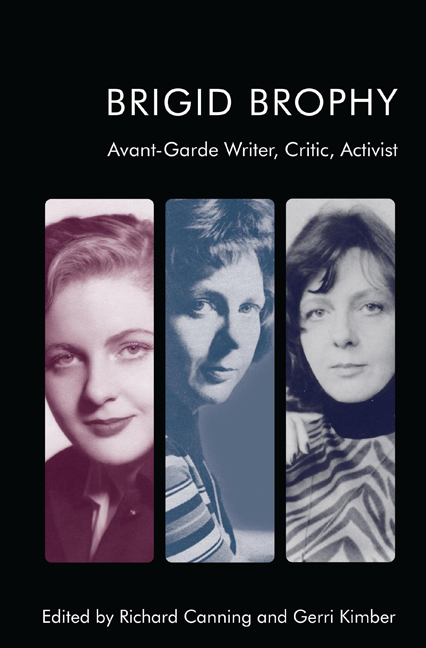Book contents
- Frontmatter
- Contents
- List of Illustrations
- Acknowledgements
- Introduction
- 1 Embodying the Fragments: A Refl ection on the Reluctant Auto-Biography of Brigid Brophy
- 2 Brigid Brophy’s Paradoxical World of Childhood
- 3 Intr oduction to ‘The Librarian and the Novel’
- 4 The Librarian and the Novel: A Writer’s View
- 5 Penetrating (the) Prancing Novelist
- 6 ‘Shavian that she was’
- 7 ‘Il faut que je vive’: Brigid Brophy and Animal Rights
- 8 Brigid Brophy’s Phenomenology of Sex in Flesh and The Snow Ball
- 9 Letter to Brigid
- 10 Encoding Love: Hidden Correspondence in the Fiction of Brigid Brophy and Iris Murdoch
- 11 ‘Heads and Boxes’: A Prop Art Exhibition Collaboration by Brigid Brophy and Maureen Duffy
- 12 Prancing Novelist and Black and White: Experiments in Biography
- 13 ‘Mo nster Cupid’: Brophy, Camp and The Snow Ball
- 14 ‘A Felicitous Day for Fish’
- 15 The Dissenting Feminist
- 16 A Certain Detachment?
- Notes on Contributors
- Index
2 - Brigid Brophy’s Paradoxical World of Childhood
Published online by Cambridge University Press: 17 October 2020
- Frontmatter
- Contents
- List of Illustrations
- Acknowledgements
- Introduction
- 1 Embodying the Fragments: A Refl ection on the Reluctant Auto-Biography of Brigid Brophy
- 2 Brigid Brophy’s Paradoxical World of Childhood
- 3 Intr oduction to ‘The Librarian and the Novel’
- 4 The Librarian and the Novel: A Writer’s View
- 5 Penetrating (the) Prancing Novelist
- 6 ‘Shavian that she was’
- 7 ‘Il faut que je vive’: Brigid Brophy and Animal Rights
- 8 Brigid Brophy’s Phenomenology of Sex in Flesh and The Snow Ball
- 9 Letter to Brigid
- 10 Encoding Love: Hidden Correspondence in the Fiction of Brigid Brophy and Iris Murdoch
- 11 ‘Heads and Boxes’: A Prop Art Exhibition Collaboration by Brigid Brophy and Maureen Duffy
- 12 Prancing Novelist and Black and White: Experiments in Biography
- 13 ‘Mo nster Cupid’: Brophy, Camp and The Snow Ball
- 14 ‘A Felicitous Day for Fish’
- 15 The Dissenting Feminist
- 16 A Certain Detachment?
- Notes on Contributors
- Index
Summary
The brilliance of Brigid Brophy lies in her ability cautiously, but unnervingly, to unveil and reveal the layers of consciousness – and unconsciousness – that construct our humanity through dreams, language, actions and moral decisions. Using Freudian theory, literature, myth, visual arts and music, her fiction and critical work is a glittering, often paradoxical, fun house of perception and invention. Yet curiously, for all her reliance on Freud and her deep concerns about human development, children and childhood are often not overtly present in her work. Sometimes, almost phantom-like, they linger in the background of the texts. As opposed to the larger genre of queer novels about childhood – James Courage’s The Young Have Secrets (1954), L. P. Hartley’s The Go-Between (1955), Maureen Duffy’s Love Child (1971) – young children sometimes fl it through Brophy’s novels as minor characters or memories, but she is not very interested in them. Frequently she has more interest in older children – adolescents and young adults – but almost always in the context of their relationships with parents or parental figures.
At the same time, however, children – and more importantly, the psychological and moral state of childhood – haunt her work. Woven through a great deal of Brophy’s analytic imagination is the paradoxical – even queer – idea of childhood as being both idyllic and horrific: a place of both innocence and dangerous, potentially deadly knowledge. There has been important new work on the concept of queer childhood, such as Karin Lesnik-Oberstein and Stephen Thomson’s important essay ‘What is Queer Theory Doing with the Child’ (2002), and Kathryn Bond Stockton’s The Queer Child, or Growing Sideways in the Twentieth Century (2009), which mostly address the liminal spaces that childhood occupies in traditional concepts of social development. These concerns are not particularly pertinent to Brophy’s world view. Brigid Brophy being Brigid Brophy – and Sigmund Freud being Sigmund Freud – the connections between children/childhood and liberating and dangerous knowledge are primarily to do with sex.
- Type
- Chapter
- Information
- Brigid BrophyAvant-Garde Writer, Critic, Activist, pp. 20 - 30Publisher: Edinburgh University PressPrint publication year: 2020



